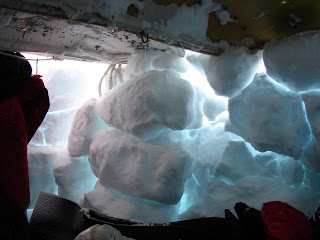Snow School – what I’ve been waiting for! I’ve heard from many Happy Camper alums all about the excitements and trials of Snow School, and now I’ve survived my own, so I can tell you first-hand what it’s really like.
So, Snow School is a two-day survival school, where you learn how to survive in the Antarctic if you are in the field or in the unfortunate position of being stranded and need rescue. My Snow School class was made up of 20 eager students and was led by 2 very capable instructors. We started out the school by going over risk management, cold weather injuries (such as frostbite, hypothermia, foot immersion, and dehydration), and proper gear use. After these class room talks, we loaded up into ice trucks and headed out to the field. Out in the field, we learned how to light a stove, pitch tents (Scott tents – especially designed for the Antartic cold, normal mountain tents, and dig snow trenches – for the case where you have no survival tent), use High Frequency Radios and Very High Frequency Radios, build snow walls to protect from the wind, and practice survival scenarios. It was really a great experience. But I think instead of babbling on, it’s more interesting to see the pictures so you can see for yourself!
Here we are, arriving in the field. Our instructor is obviously instructing us. She's emphasizing how in the field, team work is really important.
Learning to light a stove.
Pitching a Scott tent. A heavy duty tent designed to protect people from the tough Antarctic weather.
Pitching a mountain tent. A tent typically used by most campers.
Building a snow wall to protect the mountain tents from the harsh Antarctic winds.
Preparing dinner.
Taking a break from all that work. Building a snow wall is really difficult! Those blocks are heavy!
Eating dinner. Soup in a bag. yum.
My shelter for the night. All of the Happy Campers could choose where they wanted to shelter for the night. We were taught how to pitch tents and build snow trenches (basically trenches in the snow that provide shelter if you are in a survival situation without a tent). I decided to pitch in with a friend and build an igloo. Unfortunately, our igloo collapsed and we had to turn our igloo into a makeshift trench. Luckily it held well. Here's the inside. We covered the top of the trench-igloo with sleds and then packed that with snow for insulation.
It was quite cozy. It was very important to pack all of the holes with snow in order to keep out the wind and prevent spin drift (basically whipping winds inside the shelter).
Here I am, the next morning. Now who can say they've spent a night out in Antarctica - a real night out in Antarctica (without a tent).
Hooray! We survived the night. And what a night it was - a snow storm hit, but I didn't even know it - the trench-igloo was really well insulated.
Almost white out conditions at some points.
Hooray Happy Campers!
Later that day we had more trainings on survival gear.
Learned about radios.
We actually set up an HF radio and called South Pole station. The weather deteriorated a bit (here I believe it's Condition 2).
But we survived! Here we are in an ice truck, heading back to McMurdo.
Back at McMurdo, we had a final training on helicopter safety, and that was the end of Snow School. One of the key lessons I've learned here is that in survival situations, team work is really the key to survival. And, having a good team of people really made this a great experience. I've met people who I'll remember for the rest of my life. There are some things you do that you just have to bond over, and this was one of them.
Tomorrow I’m slated to head off to the field! Our helicopter flight is arranged for 1435 (military time for 2:35p). And then, it’ll be 4 weeks before I’ll be in contact with the rest of the world again. I hope things go smoothly. I guess I should say Merry Christmas and Happy New Year!! See you in 2011!































